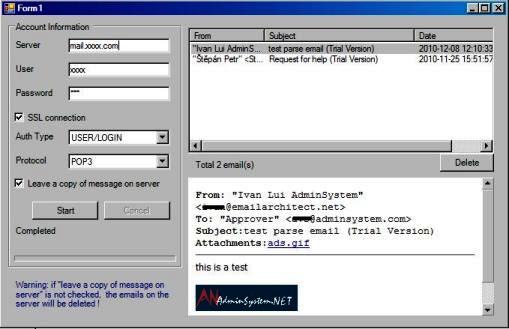Parse Email Body, Attachment and Convert Email to HTML page in C#¶
In previous section, I introduced how to parse winmail.dat. In this section, I will introduce how to parse email body and attachment, then convert email to a HTML page and display it using Web browser in C#.
Introduction¶
After the email was converted to HTML page, you can browse it with web browser. You can get everything in the HTML page such as From, To, Cc, Subject, Date, Attachments and Embedded images.
Note
Remarks: All of examples in this section are based on first section: A simple C# project. To compile and run the following example codes successfully, please click here to learn how to create the test project and add reference to your project.
[C# Example - Convert email to HTML]¶
The following example codes demonstrate how to use EAGetMail POP3 component to convert email to HTML page.
Note
To get the full sample projects, please refer to Samples section.
using System;
using System.Text.RegularExpressions;
using System.Text;
using System.IO;
using EAGetMail; //add EAGetMail namespace
namespace receiveemail
{
class Program
{
static string _formatHtmlTag(string src)
{
src = src.Replace(">", ">");
src = src.Replace("<", "<");
return src;
}
static string _formatAddresses(MailAddress[] addresses, string prefix)
{
if (addresses.Length == 0)
{
return "";
}
StringBuilder buffer = new StringBuilder();
buffer.Append(string.Format("<b>{0}:</b> ", prefix));
for (int i = 0; i < addresses.Length; i++)
{
buffer.Append(_formatHtmlTag(addresses[i].ToString()));
if (i < addresses.Length - 1)
{
buffer.Append("; ");
}
}
buffer.Append("<br>");
return buffer.ToString();
}
// We generate a html + attachment folder for every email, once the html is create,
// next time we don't need to parse the email again.
static void _generateHtmlForEmail(string emlFile, string htmlFile,
string attachmentFolder)
{
// For evaluation usage, please use "TryIt" as the license code, otherwise the
//"invalid license code" exception will be thrown. However, the object will expire in 1-2 months, then
//"trial version expired" exception will be thrown.
Mail mail = new Mail("TryIt");
mail.Load(emlFile, false);
if (mail.IsEncrypted)
{
try
{
// this email is encrypted, we decrypt it by user default certificate.
// you can also use specified certificate like this
// oCert = new Certificate();
// oCert.Load("c:\\test.pfx", "pfxpassword", Certificate.CertificateKeyLocation.CRYPT_USER_KEYSET)
// oMail = oMail.Decrypt( oCert );
mail = mail.Decrypt(null);
}
catch (Exception ep)
{
Console.WriteLine(ep.Message);
}
}
if (mail.IsSigned)
{
try
{
// This email is digital signed.
Certificate signerCertificate = mail.VerifySignature();
Console.WriteLine("This email contains a valid digital signature.");
// You can add the certificate to your certificate storage like this
// cert.AddToStore( Certificate.CertificateStoreLocation.CERT_SYSTEM_STORE_CURRENT_USER,
// "addressbook" );
// then you can use send the encrypted email back to this sender.
}
catch (Exception ep)
{
Console.WriteLine(ep.Message);
}
}
// Decode winmail.dat (Outlook TNEF stream) automatically.
// also convert RTF body to HTML body automatically.MO
mail.DecodeTNEF();
string html = mail.HtmlBody;
StringBuilder header = new StringBuilder();
header.Append("<font face=\"Courier New,Arial\" size=2>");
header.Append("<b>From:</b> " + _formatHtmlTag(mail.From.ToString()) + "<br>");
header.Append(_formatAddresses(mail.To, "To"));
header.Append(_formatAddresses(mail.Cc, "Cc"));
header.Append(string.Format("<b>Subject:</b>{0}<br>\r\n", _formatHtmlTag(mail.Subject)));
Attachment[] attachments = mail.Attachments;
if (attachments.Length > 0)
{
if (!Directory.Exists(attachmentFolder))
Directory.CreateDirectory(attachmentFolder);
header.Append("<b>Attachments:</b> ");
for (int i = 0; i < attachments.Length; i++)
{
Attachment attachment = attachments[i];
string attachmentName = string.Format("{0}\\{1}", attachmentFolder, attachment.Name);
attachment.SaveAs(attachmentName, true);
header.Append(string.Format("<a href=\"{0}\" target=\"_blank\">{1}</a> ",
attachmentName, attachment.Name));
if (attachment.ContentID.Length > 0)
{ // Show embedded image.
html = html.Replace("cid:" + attachment.ContentID, attachmentName);
}
}
}
// Change original meta header encoding to utf-8
Regex reg = new Regex("(<meta[^>]*charset[ \t]*=[ \t\"]*)([^<> \r\n\"]*)", RegexOptions.Multiline | RegexOptions.IgnoreCase);
html = reg.Replace(html, "$1utf-8");
if (!reg.IsMatch(html))
{
header.Insert(0, "<meta HTTP-EQUIV=\"Content-Type\" Content=\"text/html; charset=utf-8\">");
}
html = header.ToString() + "<hr>" + html;
using (FileStream stream = new FileStream(htmlFile, FileMode.Create, FileAccess.Write, FileShare.None))
{
byte[] buffer = Encoding.UTF8.GetBytes(html);
stream.Write(buffer, 0, buffer.Length);
stream.Close();
}
}
static void ConvertMailToHtml(string emlFile)
{
try
{
int pos = emlFile.LastIndexOf(".");
string attachmentFolder = emlFile.Substring(0, pos);
string htmlFile = attachmentFolder + ".htm";
if (!File.Exists(htmlFile))
{
// We haven't generate the html for this email, generate it now.
_generateHtmlForEmail(emlFile, htmlFile,attachmentFolder);
}
Console.WriteLine("Please open {0} to browse your email",
htmlFile);
}
catch (Exception ep)
{
Console.WriteLine(ep.Message);
}
}
static void Main(string[] args)
{
ConvertMailToHtml("c:\\my folder\\test.eml");
}
}
}
In EAGetMail installer, there are many samples demonstrate how to use Web browser control to display the email, I suggest that you download it and have a try

Next Section
At next section I will introduce how to parse Non-delivery report.
Appendix
- EAGetMail POP3/IMAP4 Component SDK
- Using UIDLManager to mark email as read/downloaded
- Download only unread/new emails from IMAP or MS Exchange Server
- Search emails and filter emails on IMAP or MS Exchange Server
- Retrieve emails from specified folder in IMAP or MS Exchange Server
- Parse Outlook .MSG file
- Export emails from Outlook INBOX or PST file
- Import emails to Outlook INBOX or PST file
Comments
If you have any comments or questions about above example codes, please click here to add your comments.
